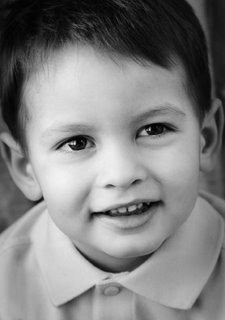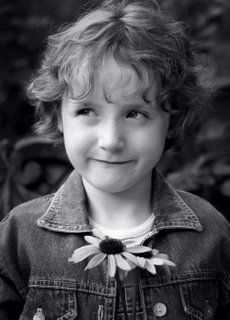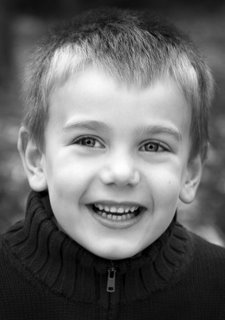The Bank One building in downtown Chicago
Wednesday, February 08, 2006
Sunday, January 29, 2006
Ballad of the one-armed photographer
 Well, tomorrow is the day I go under the knife to get my gimpy right shoulder fixed. Minor surgery, major hassle, at least for 6-8 weeks.
Well, tomorrow is the day I go under the knife to get my gimpy right shoulder fixed. Minor surgery, major hassle, at least for 6-8 weeks. I had a good tome shooting with the two kids I mentioned last time. We crawled around and found some cool places to shoot in their sun-washed living room. I just used a couple of diffusers and one reflector to fill things in a bit.
Now that I am getting more comfortable shooting inside with available light I think I am going to enjoy doing more of it.
At least once I can shoot again.
james
Friday, January 20, 2006
Wish me luck
 I have a photo shoot tomorrow, a nice local family with two small kids.
I have a photo shoot tomorrow, a nice local family with two small kids.I am photographing in their home and I plan to do the whole thing with available light as I usually do, but inside instead of outside. (it’s a bit cold in Chicago right now.)
I am encouraged by the fact that the mother of the two kids contacted me after seeing only one print of mine that is one of my favorite images.
The point is that she wants me to make images of her kids that look like the images I like to make.
Exactly the point of being an artist for hire.
I get plenty of the “oh, you’re a photographer, can you take pictures at the church fund-raiser?”, “do you do weddings?” and “I need a headshot for my company directory.” It is refreshing to hear “I saw your stuff, I love the image of X, I want to hire you.”
And it is music to my ears when I ask them what they have in mind and they say “you’re the artist, you tell me.”
The problem is this is the last shoot for a while.
I am having surgery on my right shoulder a week from next Monday and the recovery is a bit painful and debilitating. I’m not expecting to be able to lift a camera for about 6-8 weeks. Horrors!
Well, hopefully that will mean that I have time to think and post some more rants about photos and art and stuff.
james
photoblogoshpere
Being a new photo-blogger I thought I would investigate various photo blogs on the web and see what was out there.
I wish I was more inspired.
What I have found fall into the following categories:
Gear blogs
- Frankly, these seem to be blatant attempts to sell ad space
- These have their place. Hey, I visit DPReview daily. I don’t know why, I just do.
- Tips that are self-evident to all but newby photogs.
- Endless discussions comparing minute details of gear.
Image blogs
- Everything I photograph with my cellphone camera!
- All of “my” images – many of these are good because there is an inherent continuity based upon a single author. The problem is that there are a lot of poor artists out there.
Concept blogs
- Hey, how about a picture every day!
- Better yet, a self portrait every day!
- A different photographer every day! (these have some merit and freshness)
Progress blogs
- Photographers working on a project giving regular updates
- Photographers who put up only the good images they make
Training blogs
- How to photograph X
Random thought blogs
- I guess I fall into this category
- People talking about concepts that usually have to deal with photography, with an occasional reference to technique, gear, and stuff
I guess not finding what you are looking for most often comes of not knowing what you are looking for. After my initial search the progress blogs are resonating with me the most.
It seems that more good artists have flocked together on the internet than have struck out on their own. i.e. I have seen some great stuff at Deviant art and UTATA but have not seen many really good independent artist sites or blogs. Does this seem ironic to anyone but me?
Do artists flock to aggregation on the internet and shun them in the flesh and blood world because on-line they don’t have to deal with people face to face?
My favorite blog is Take Pictures, the blog of Clay Enos. It is the one that inspired my to start blogging
Clay is a prolific artist
There is always something new
Clay is a good photographer
It would be boring to follow the travels and travails of a mediocre photographer.
Clay is not overtly self promoting
You really feel the guy is just blogging to have a creative outlet, to inspire others and to share experiences, not as a marketing vehicle or whatever.
Clay is passionate about what he does
He speaks from the gut
He takes a lot of images (For Christ sake, he takes the StreetStudio on vacation!)
Clay is interesting
His blog reads like a diary, and who doesn’t like getting into someone else’s head?
He talks about his work and his thoughts
He seems like a good human
Another good one is Brooks Ayola's blog
Brooks is a really good studio photographer
He shares lots of how-to info and color commentary about shooting
He photographs beautiful women which is always nice.
More photographers should do what Clay and Brooks are doing, posting work in progress, talking about what they are doing, what they are trying to do, what they are succeeding at, experimenting with, discussing a tad of technique, a bit of concept and posting a bunch of images.
james
I wish I was more inspired.
What I have found fall into the following categories:
Gear blogs
- Frankly, these seem to be blatant attempts to sell ad space
- These have their place. Hey, I visit DPReview daily. I don’t know why, I just do.
- Tips that are self-evident to all but newby photogs.
- Endless discussions comparing minute details of gear.
Image blogs
- Everything I photograph with my cellphone camera!
- All of “my” images – many of these are good because there is an inherent continuity based upon a single author. The problem is that there are a lot of poor artists out there.
Concept blogs
- Hey, how about a picture every day!
- Better yet, a self portrait every day!
- A different photographer every day! (these have some merit and freshness)
Progress blogs
- Photographers working on a project giving regular updates
- Photographers who put up only the good images they make
Training blogs
- How to photograph X
Random thought blogs
- I guess I fall into this category
- People talking about concepts that usually have to deal with photography, with an occasional reference to technique, gear, and stuff
I guess not finding what you are looking for most often comes of not knowing what you are looking for. After my initial search the progress blogs are resonating with me the most.
It seems that more good artists have flocked together on the internet than have struck out on their own. i.e. I have seen some great stuff at Deviant art and UTATA but have not seen many really good independent artist sites or blogs. Does this seem ironic to anyone but me?
Do artists flock to aggregation on the internet and shun them in the flesh and blood world because on-line they don’t have to deal with people face to face?
My favorite blog is Take Pictures, the blog of Clay Enos. It is the one that inspired my to start blogging
Clay is a prolific artist
There is always something new
Clay is a good photographer
It would be boring to follow the travels and travails of a mediocre photographer.
Clay is not overtly self promoting
You really feel the guy is just blogging to have a creative outlet, to inspire others and to share experiences, not as a marketing vehicle or whatever.
Clay is passionate about what he does
He speaks from the gut
He takes a lot of images (For Christ sake, he takes the StreetStudio on vacation!)
Clay is interesting
His blog reads like a diary, and who doesn’t like getting into someone else’s head?
He talks about his work and his thoughts
He seems like a good human
Another good one is Brooks Ayola's blog
Brooks is a really good studio photographer
He shares lots of how-to info and color commentary about shooting
He photographs beautiful women which is always nice.
More photographers should do what Clay and Brooks are doing, posting work in progress, talking about what they are doing, what they are trying to do, what they are succeeding at, experimenting with, discussing a tad of technique, a bit of concept and posting a bunch of images.
james
Wednesday, January 18, 2006
Photo-talk
 The last rant on sharpness got me thinking about evaluating photography in a broader sense.
The last rant on sharpness got me thinking about evaluating photography in a broader sense.Ever notice that discussions of photography between photographers revolve around technology far more than around imagery?
I had some thoughts on why this is:
1) Photography is an inherently technical medium
2) Photography is dominated by guys
3) Photography attracts geeks
4) Photography is a low-brow art form i.e. it is so easily accessible that anyone can do it and therefore it is done (no offense, hey, I’m a photographer!)
5) It is easier and safer to talk about gear than soft and fuzzy things like art and feelings.
6) It is easy to get flamed expressing soft and fuzzy opinions.
7) Talking about art is kind of “girly.” (see point 2)
Therefore it’s easier to talk about how to achieve silky grey tone transition rather than talking about images that have silky grey tone transition, or god forbid, images in which silky greytone transition is an essential element of the composition and essence of the image.
How can we get over this and talk about the things that are important to making our images work better formally rather than just technically.
It occurs to me that all of the list members on the “Digital B&W The Print” yahoo group should hold a juried exhibit of their 21-step grey scale wedges with reflective density measurements and LAB values carefully notated. The exhibit would be judged by the ability to achieve a numerically ideal tone progression within the broadest range of densities. Above each wedge (and the blue ribbons), we could display an image by each artist that they consider the pinnacle of their artistry. These entries would be judged on purely artistic criteria. Is there a correlation between technical mastery and artistry?
I'll say it again, technical competence is not the goal. It is merely a milepost on the way to a greater challenge: the ability to make meaningful images. The surprise: images do not need to be technically perfect to be artistically significant, or every artistically great.
Let’s try to talk about images rather than image making.
Disclaimer: I fully realize the hypocritical nature of the above comments. I am a male, I have been described as a geek, and I have a relatively low-brow level of art appreciation (I have a Masters in Design for God’s sake!) and I really like the technology. This rant is just a part of my 12 step program to come to terms with my own issues and get over the things that are holding me back from being a better artist.
Saturday, January 14, 2006
Ranting about Sharpness
 Submitted for debate: Sharpness is overrated.
Submitted for debate: Sharpness is overrated.Slavish pursuit of sharpness is the crutch of the visually weak.
The pursuit of sharpness is the essence of missing the forest for the trees.
I know that it is generally good and an obvious expectation for photographs to be in focus, but I guess I have just matured to the point that I think that pursuing sharpness gets in the way of more important elements of making evocative images.
I have found more great images that are technically imperfect than I have found in all of the technically perfect images I have seen.
I was like most budding photographers when I was younger. The struggle of achieving technical competence makes you a slave to the technology and frankly focuses one on all the wrong things.
• The greatest struggle in the art of photography is not achieving technical competency, it is getting beyond technical competency.
True, the focus of my subject matter changed from trees and rocks to portraiture, but I really don’t think that matters.
I liken it to the difference between a pianist and a composer. One can perform great music, the other creates great music by understanding the nature of the instrument and pushing it to its limits to make something new and original.
Do this: look through a bunch of photo books and find some work that you really admire. Now, notice what percentage of them is sharp. I was stunned when I did this exercise. At least 75% of the portraits I consider to be the best would I identify as sharp.
Ask yourself some questions:
• Does the lack of sharpness detract from the effectiveness of good images?
• Does the lack of sharpness contribute to the effectiveness of good images?
• What makes an image great to you?
• Can you find common elements that you are responding to?
• What are your images saying?
• What do you want them to say?
Pursue perfect images, not perfect technique.
A perfectly exposed, contact printed 8x10 negative that carries focus from foreground to background, has great tonal range, beautifully printed on silver rich bromide paper, archivally processed and selenium toned may be hard to do, but that don’t make it art!
Tuesday, December 20, 2005
Now for something completely different.

I thought I would work with some equipment I had not used in a while.
Here is a shot of my youngest daughter taken in style I haven’t worked with for about 20 years.
I used a 20” beauty dish and a Big Ol Reflector (BOR) and popped the background to blow it out. I did some work in Photoshop to create a silky, high-contrast look.
I like this style and look, unfortunately, this makes my 5 year old look like a teenager.
Talk about a departure from my usual style!
jh
Monday, December 19, 2005
The essence of “Natural”
 I have done a lot of thinking lately about what makes an image seem “Natural”.
I have done a lot of thinking lately about what makes an image seem “Natural”.I will keep coming back to this theme from time to time. I haven’t defined all of the “Rules of Natural Photography” but I have a good start. I will share them now and expand upon them further as we go along.
What are the visual cues that a picture is “Natural”:
• Complex backgrounds
• Light is often coming from unusual directions
Slightly too low or too high
• One main light source
• Complex ambient lighting
• Complex catch lights in eyes
• Tiny catch lights in eyes
• Broad light source creating hair light (the sky)
• Light source is visible (window)
• Apparent depth creates light falloff
• Identifiable background
• Background dark on bottom, light on top
• Lighting Harmony
Continuity of lighting direction and intensity (especially hard lighting)
• Lighting of background compliments subject lighting (direction, character)
• Atmospheric lighting
• Messiness
Blown out highlights
Windblown hair
Clutter
Texture
Environment
The “tells” of “artificial” photography
• Light character and fall off that scream “light box!” or “Umbrella!”
• Painted backdrops
• Props of any kind
• Black turtlenecks
• White turtlenecks
• Perfect hair
• Hair lights (rim light, kicker)
• Light coming from too many directions
• Light that is either too even or too direct
Subscribe to:
Comments (Atom)